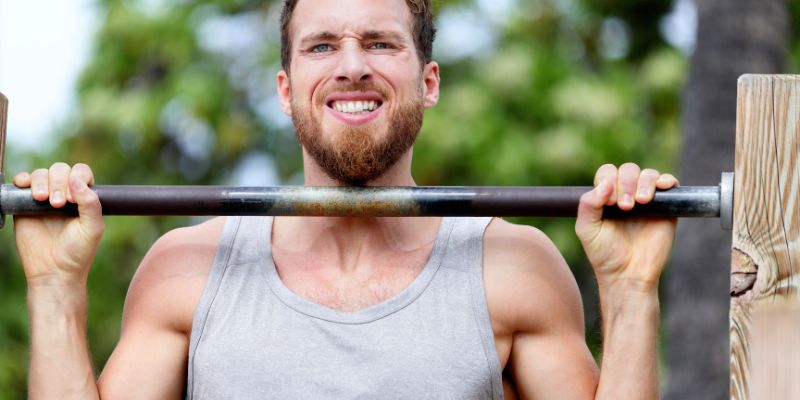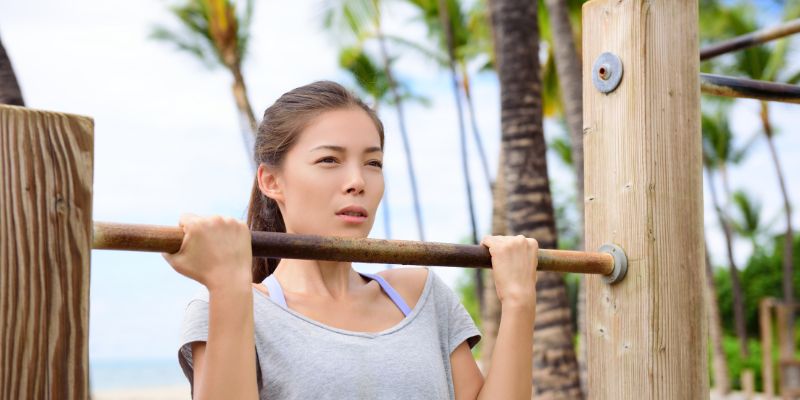Pullups and chinups are the mainstays of upper body workouts for increasing strength. Although they seem identical, these two motions target different muscle groups and offer different advantages. Knowing the variations between pullups and chinups will enable you to decide which best meets your fitness objectives.
In this article, we will discuss what distinguishes these two exercises, from grip variations to muscle engagement, so you may maximize your workout. Let us now explore the salient features and main points of each.
Grip Difference Between Pullups and Chinups
The most obvious variation between pullups and chinups is the grip, which greatly influences which muscles are used. Your palms are in a pullup, face away from you, and employ a pronated or overhand grip. Usually, this grip emphasizes your back muscles moreespecially the laisses dorsi. A pullup grip can also be difficult for novices because of its emphasis on upper back and shoulder strength.
Conversely, chinups employ an underhand or supinated grip in which your palms face you. This change of grip brings the biceps more under active use. Since chinups let the arms contribute more, many consider them a somewhat simpler movement. Knowing these differences helps you decide which exercise fits your degree of fitness and muscle emphasis.
Muscle Engagement in Pullups vs. Chinups
Although both workouts target related muscle groups, the varied grips affect which muscles are given priority. With their pronated grip, pullups mostly target the rhomboids and upper back, especially the laisses dorsi. Though to a lesser degree than with chinups, secondary muscles such as the biceps, shoulders, and forearms also come into action.
By comparison, the underhand grip of the chinup emphasizes the biceps more deliberately. Chinups still work the back muscles, but for individuals with stronger arms, the arms help more greatly and might make them feel simpler. Chinups are also a fantastic choice for those trying to develop greater definition in the lower lats.
Benefits of Pullups
Anyone trying to increase their upper body strength will find a variety of advantages from pullups. Targeting the upper back of the exercise helps to improve posture and balance, so one of the key benefits is its ability to Pullups also require significant core stability. Hence, you will develop your abdominals in tandem with your upper body.
Pullups are a great choice for a complete upper-body exercise. Advanced athletes and those seeking strength without depending on weights may especially benefit from them. This workout will increase your general pulling power, shoulder health, and grip strength.

Benefits of Chinups
Chinups are a popular choice for novices because of their advantages. For those with stronger arms than backs, chinups are typically easier since the underhand hold emphasizes the biceps. Developing pull strength and getting ready for pullups makes chinups a great beginning point.
Chinups are also excellent for isolating the lower lats. Hence, they might be the better alternative if you want a superior definition in that area. They also enable more arm range of motion, which might help muscles develop and increase flexibility. Chinups are a useful exercise for everyone trying to develop basic strength in the upper body since they let you concentrate on the arms and back with less chance of injury.

When to Use Pullups or Chinups
Pullups and chinups should be chosen mostly depending on your fitness objectives and present strength level. Pullups may be preferable if you aim to improve posture and develop more robust back muscles. Pullups test the upper back, which is ideal for people with some upper body strength experience.
However, chinups are perfect for people trying to boost arm strength or who are just starting to develop their upper body. Chinues provide a fantastic beginning to bodyweight exercises and can be simpler depending on the involvement of the biceps.
Pullup and Chinup Variations for Progression
Pullups and chinups come in several forms to help you advance and stay off a plateau. Some well-liked pullups are wide-grip pullups, which emphasize the upper back and shoulders even more, and close-grip pullups, which can activate the lower back and biceps more. To challenge your strength limits and increase intensity, consider weighted pullups.
For chinups, consider doing close-grip chinups or adding a slow, under-control eccentric (lowering phase). This method may develop muscle endurance. Combining variants of both exercises guarantees a well-rounded workout that constantly pushes your muscles, strengthening them and avoiding burnout.
Common Mistakes in Pullups and Chinups
Correct form is crucial for avoiding injury and optimizing muscular activation during pullups or chinups. In these activities, a common error is depending too much on momentum, which lowers muscle involvement and could damage the shoulder joints. Rather, concentrate on under-control motions and try not to swing.
Another common mistake is not involving the core. Keeping the core strong helps you support your body's alignment and avoid too much lower back strain. Pay attention also to your grasp. While a narrow grasp can limit the range of motion for chinups, an overly wide grip can strain the shoulders unnecessarily for pullups. Improving your form in every workout will lower injury risks and maximize outcomes.
Pullups vs Chinups: Which is Best for You?
Ultimately, your objectives will determine which pullups and chinups are "best." Pullups are perfect for individuals with greater upper body experience since they help highlight your back and raise general upper body strength. Chinups are the more appropriate choice to improve your arms while still training your back, particularly if you recently started bodyweight workouts.
Pullups and chinups combined in an exercise regimen provide the ideal of both worlds for many folks. This method guarantees a balanced, efficient exercise targeting your back and arms, allowing you to develop strength and endurance across all main upper body muscles.
Conclusion:
Although they offer great upper body exercises, pullups, and chinups have varied uses depending on their different grips and muscular involvement. While chinups concentrate more on the biceps and lower lats, pullups are ideal for strengthening back muscles and correcting posture. Including one or both workouts into your routine will help you reach a stronger, more developed upper body, depending on your fitness goals. These are adaptable, efficient, and worth adding to your workout regardless of expertise level.







